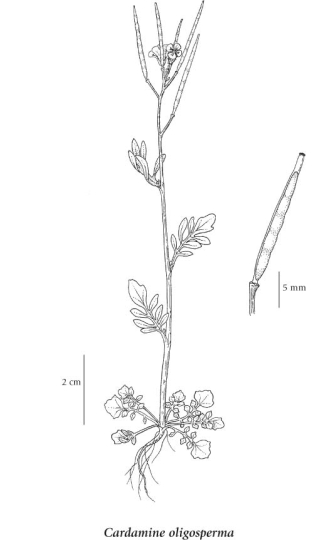Cardamine oligosperma Nutt.
little western bitter-cress (alpine bitter-cress; Siberian bitter-cress)
Brassicaceae (Mustard family)
Introduction to Vascular Plants
little western bitter-cress (alpine bitter-cress; Siberian bitter-cress)
Brassicaceae (Mustard family)
Introduction to Vascular Plants
Species Information
General:
Annual or biennial (var. oligosperma) or perennial (var. kamtschatica) herb from a taproot; stems erect to ascending, one or more, freely branched, 10-50 cm tall, hairs short or lacking.
Leaves:
Basal leaves forming a rosette; stem leaves similar, pinnate, sparsely stiff-hairy to hairy-fringed to almost glabrous, lateral lobes (2) 3-10, shortly-stalked to stalked, oblanceolate to egg-shaped, entire or shallowly 2 to several times round-toothed or lobed, 3-20 mm long, the terminal leaflet usually larger, to 3 cm long.
Flowers:
Inflorescence an elongate racemes, more or less umbel-like, 3-10 cm long, generally lacking bracts; flower stalks erect to ascending, 5-20 mm long; petals white, 2-4 mm long; sepals 1-2 mm long.
Fruits:
Siliques, erect, 1.5-2.5 cm long, 1-1.5 mm wide, glabrous to sparsely hairy; styles less than 0.5 mm long; seeds 15-22 (24), 1.5-2 mm long, oblong-oval, narrowly wing-margined.
Notes:
Two rather weak varieties occur in BC.
1. Racemes more or less umbel-like, the central axis 1-2 cm long; plants of the upper montane to alpine zones...................... var. kamtschatica (Regel) Detling
1. Racemes more elongate, the central axis greater than 3 cm long; plants of the lowland and lower montane zones............................ var. oligosperma
Illustration

If more than one illustration is available for a species (e.g., separate illustrations were provided for two subspecies) then links to the separate images will be provided below. Note that individual subspecies or varietal illustrations are not always available.
Illustration Source: The Illustrated Flora of British Columbia
USDA Species Characteristics
Flower Colour:
White
Blooming Period:
Early Spring
Fruit/Seed characteristics:
Colour: Black
Present from Spring to Summer
Source: The USDA
Ecology
Ecological Framework for Cardamine oligosperma
The table below shows the species-specific information calculated from
original data (BEC database) provided by the BC Ministry of Forests and Range.
(Updated August, 2013)
The table below shows the species-specific information calculated from
original data (BEC database) provided by the BC Ministry of Forests and Range.
(Updated August, 2013)
| Site Information |
Value / Class |
||
|
Avg |
Min |
Max |
|
| Elevation
(metres) |
940 | 0 | 2107 |
| Slope
Gradient (%) |
19 | 0 | 85 |
|
Aspect (degrees) |
324 | 0 | 353 |
| Soil
Moisture Regime (SMR) [0 - very xeric; 4 - mesic; 8 - hydric] |
4 | 1 | 8 |
| Modal
Nutrient Regime
Class |
D | ||
| #
of field plots species was recorded in: |
85 | ||
| Modal
BEC Zone Class |
CWH | ||
|
All BEC Zones (# of stations/zone) species was recorded in |
BAFA(6), BWBS(1), CDF(13), CWH(15), ESSF(14), ICH(12), IDF(2), MH(8), MS(3), PP(1), SBPS(2), SBS(7) | ||
|
Source:
Klinkenberg 2013
|
|||
Habitat and Range
Wet to mesic streamsides, ditches, waste places, roadsides, meadows, gravelly slopes and open woods in the lowland to alpine zones; var. oligosperma - common in S BC, less frequent northward, var. kamtschatica - frequent in coastal and N BC; var. oligosperma - S to MT and CA, var. kamtschatica - amphiberingian, N to AK, YT and NT, E to AB and S to OR; E. Asia.Status Information
Synonyms
Synonyms and Alternate Names:
Cardamine oligosperma sensu lato
Cardamine oligosperma var. oligosperma Nutt.